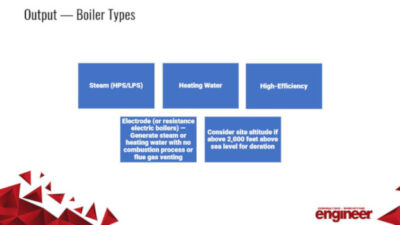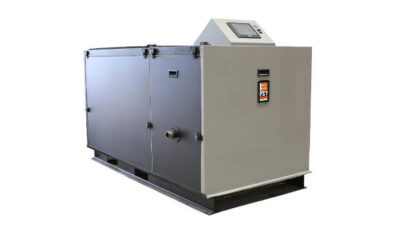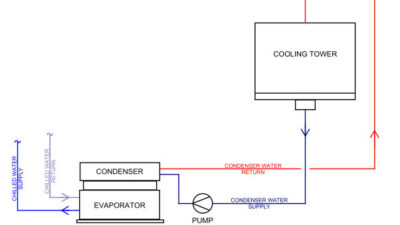A hospital’s operating room air handling units (AHUs) were updated to meet new requirements.
Carilion Clinic, a nonprofit health care system in Virginia, set out to create “operating rooms of the future” at its New River Valley Medical Center in Christianburg, Va., which included transitioning operating methods to a more hybrid approach, adopting cutting-edge technology, and becoming a teaching facility.
To make this dream happen, Carilion began upgrading its operating suites’ air handling units (AHUs). Designed in the mid-1990s, the existing operating suite AHUs were adequate for standard operations, but they would not be able to handle the new loads introduced during the transition. The design team was tasked to replace the existing AHUs with larger and more resilient units that can meet the new load and lower temperature requirements—the surgeons were requiring a temperature of 62°F at 40% relative humidity (RH).
The new AHUs were specified to be customized for two reasons:
-
The units were required to serve a critical environment where close environmental conditions were highly important for patient safety.
-
The units are located on the roof, thus the owner needed resilient equipment with a longer service life than the existing modular AHUs.
Three manufacturers were listed, and the team ensured that all listed manufacturers could meet every detail in the specification. The unit was specified to be 4-in., double-wall construction and not to exceed 0.5% of total airflow leakage at the maximum design static pressure or the cubic feet per minute allowed for SMACNA Leakage Class 5. Specific details of the unit base were called out in the specification including, but not limited to, structural steel base material, flooring, base-frame height, deflection, and sufficient height for condensate P-trap installation.
The specification of the unit casing also was very important. To maintain the integrity of the unit and to minimize rust and leakage, the wall assemblies were specified as follows:
-
Double-wall galvanized steel construction. The entire unit was specified to have a solid-wall aluminum liner on the interior. All spaces and joints of wall assemblies were completely sealed. All walls met the casing deflection limits.
-
A thermal break was provided throughout the entire wall assembly to ensure that no member on the exterior of the unit, including fasteners, has thorough metal contact with any member on the interior of the unit—including fasteners.
-
Wall and roof panel insulation were 4-in.-thick, R-25 moisture-resistant polyisocyanurate foam protected by solid interior liner. The interior liner was aluminum. Isolation was required between the steel casing and frame and an aluminum liner to avoid galvanic corrosion.
Condensate drain pans were specified to be stainless steel and to have 2% slope in at least two planes to ensure proper collection from cooling coils. Condensate drain pans also were specified to have the following:
-
Length: Extend the drain pan downstream from the leaving face of the coil to comply with ASHRAE Standard 62.1, which recommends one-half of the installed vertical dimension of the coil or assembly.
-
Depth of the drain pan: A minimum of 2 in. deep (vertical height).
Fans were selected to be statically and dynamically balanced and designed for continuous operation at maximum-rated fan speed and motor horsepower. Fans also were selected to operate at a point no higher than 90% of the peak static pressure ratings, as defined by the fan-performance curve at the selected operating speed.
The supply- and return-fan sections were specified to be arrays with four fans on the supply and return of each unit. It was important to ensure that each fan and motor assembly be independently isolated within the structural assembly using spring isolators, 2-in. deflection in this case. Isolators were specified to be mounted in a three-point arrangement to provide both vertical and horizontal isolation and did not require field adjustment.
Fans and motors assemblies were specified to be designed such that a natural frequency would not exist within the operating rotations-per-minute range of the fan, eliminating the need for lockout frequency settings in the variable frequency drives (VFDs). The lockout feature isn’t required if the various fan assemblies are independently isolated to avoid a coincident natural frequency with the frame assembly. Each fan was specified to be provided with an isolation damper that closed in the event of a motor failure to prevent air bypass through the off fan.
One VFD was specified for each fan. This was a client requirement because of resiliency. Traditional fan arrays supply and return fans can be specified with one VFD serving the supply-fan array and one VFD supplying the return-fan array. The owner didn’t want to run the risk of losing operation of the sole VFD for each array because that would prevent the operation of the AHU that is serving the surgery suites.
Filters were specified to be MERV 8 prefilter and air cleaner system, and MERV 14 as final filters. A Type II desiccant system was specified to obtain the low-humidity conditions that the surgeons requested (62°F at 40% RH). A Type II system also requires significant heating of the regeneration airstream to remove the moisture from the wheel. This adds sensible heat to the cooling airstream. The desiccant system is not usually required for energy-efficient operation except where very low dewpoint air is required, such as in a surgical environment. Steam-dispersion humidifiers were specified at the unit along with trim humidifiers in the ductwork to maintain the stringent humidity requirements.
The final product was a well-selected AHU that was installed per engineer specification. The facility staff and surgeons were very pleased with the environmental condition of their space after the installation.
Garold “Gary” Hamilton is a senior vice president and health care practice lead at WSP. He was a 2015 40 Under 40 award winner.



